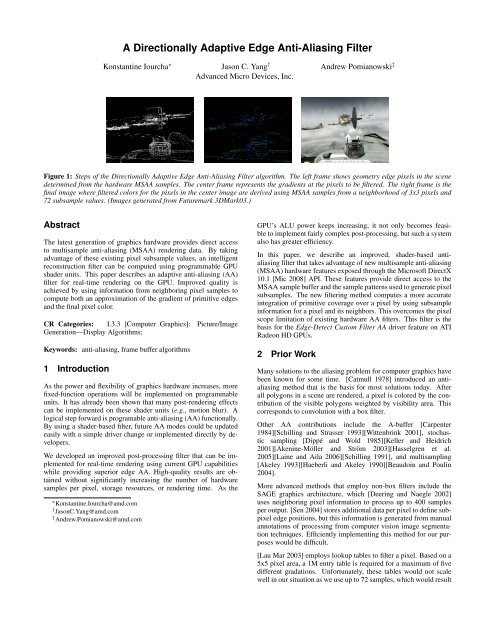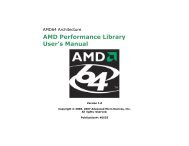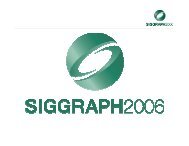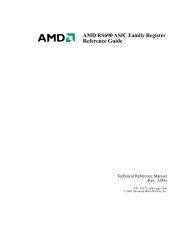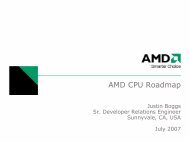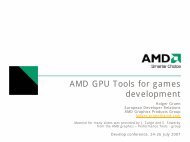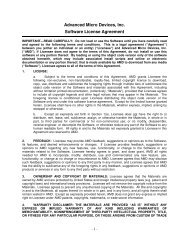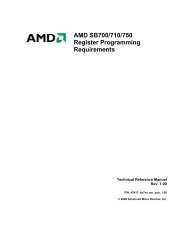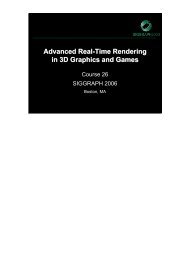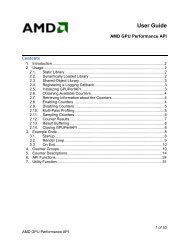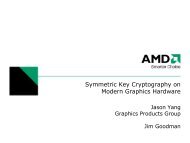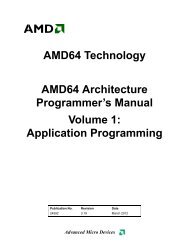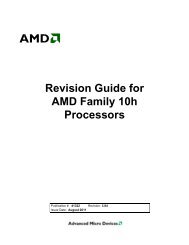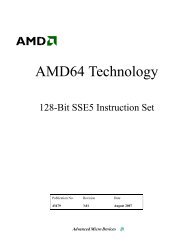A Directionally Adaptive Edge Anti-Aliasing Filter - AMD Developer ...
A Directionally Adaptive Edge Anti-Aliasing Filter - AMD Developer ...
A Directionally Adaptive Edge Anti-Aliasing Filter - AMD Developer ...
You also want an ePaper? Increase the reach of your titles
YUMPU automatically turns print PDFs into web optimized ePapers that Google loves.
A <strong>Directionally</strong> <strong>Adaptive</strong> <strong>Edge</strong> <strong>Anti</strong>-<strong>Aliasing</strong> <strong>Filter</strong><br />
Konstantine Iourcha ∗ Jason C. Yang †<br />
Advanced Micro Devices, Inc.<br />
Andrew Pomianowski ‡<br />
Figure 1: Steps of the <strong>Directionally</strong> <strong>Adaptive</strong> <strong>Edge</strong> <strong>Anti</strong>-<strong>Aliasing</strong> <strong>Filter</strong> algorithm. The left frame shows geometry edge pixels in the scene<br />
determined from the hardware MSAA samples. The center frame represents the gradients at the pixels to be filtered. The right frame is the<br />
final image where filtered colors for the pixels in the center image are derived using MSAA samples from a neighborhood of 3x3 pixels and<br />
72 subsample values. (Images generated from Futuremark 3DMark03.)<br />
Abstract<br />
The latest generation of graphics hardware provides direct access<br />
to multisample anti-aliasing (MSAA) rendering data. By taking<br />
advantage of these existing pixel subsample values, an intelligent<br />
reconstruction filter can be computed using programmable GPU<br />
shader units. This paper describes an adaptive anti-aliasing (AA)<br />
filter for real-time rendering on the GPU. Improved quality is<br />
achieved by using information from neighboring pixel samples to<br />
compute both an approximation of the gradient of primitive edges<br />
and the final pixel color.<br />
CR Categories: I.3.3 [Computer Graphics]: Picture/Image<br />
Generation—Display Algorithms;<br />
Keywords: anti-aliasing, frame buffer algorithms<br />
1 Introduction<br />
As the power and flexibility of graphics hardware increases, more<br />
fixed-function operations will be implemented on programmable<br />
units. It has already been shown that many post-rendering effects<br />
can be implemented on these shader units (e.g., motion blur). A<br />
logical step forward is programable anti-aliasing (AA) functionally.<br />
By using a shader-based filter, future AA modes could be updated<br />
easily with a simple driver change or implemented directly by developers.<br />
We developed an improved post-processing filter that can be implemented<br />
for real-time rendering using current GPU capabilities<br />
while providing superior edge AA. High-quality results are obtained<br />
without significantly increasing the number of hardware<br />
samples per pixel, storage resources, or rendering time. As the<br />
∗ Konstantine.Iourcha@amd.com<br />
† JasonC.Yang@amd.com<br />
‡ Andrew.Pomianowski@amd.com<br />
GPU’s ALU power keeps increasing, it not only becomes feasible<br />
to implement fairly complex post-processing, but such a system<br />
also has greater efficiency.<br />
In this paper, we describe an improved, shader-based antialiasing<br />
filter that takes advantage of new multisample anti-aliasing<br />
(MSAA) hardware features exposed through the Microsoft DirectX<br />
10.1 [Mic 2008] API. These features provide direct access to the<br />
MSAA sample buffer and the sample patterns used to generate pixel<br />
subsamples. The new filtering method computes a more accurate<br />
integration of primitive coverage over a pixel by using subsample<br />
information for a pixel and its neighbors. This overcomes the pixel<br />
scope limitation of existing hardware AA filters. This filter is the<br />
basis for the <strong>Edge</strong>-Detect Custom <strong>Filter</strong> AA driver feature on ATI<br />
Radeon HD GPUs.<br />
2 Prior Work<br />
Many solutions to the aliasing problem for computer graphics have<br />
been known for some time. [Catmull 1978] introduced an antialiasing<br />
method that is the basis for most solutions today. After<br />
all polygons in a scene are rendered, a pixel is colored by the contribution<br />
of the visible polygons weighted by visibility area. This<br />
corresponds to convolution with a box filter.<br />
Other AA contributions include the A-buffer [Carpenter<br />
1984][Schilling and Strasser 1993][Wittenbrink 2001], stochastic<br />
sampling [Dippé and Wold 1985][Keller and Heidrich<br />
2001][Akenine-Möller and Ström 2003][Hasselgren et al.<br />
2005][Laine and Aila 2006][Schilling 1991], and multisampling<br />
[Akeley 1993][Haeberli and Akeley 1990][Beaudoin and Poulin<br />
2004].<br />
More advanced methods that employ non-box filters include the<br />
SAGE graphics architecture, which [Deering and Naegle 2002]<br />
uses neighboring pixel information to process up to 400 samples<br />
per output. [Sen 2004] stores additional data per pixel to define subpixel<br />
edge positions, but this information is generated from manual<br />
annotations of processing from computer vision image segmentation<br />
techniques. Efficiently implementing this method for our purposes<br />
would be difficult.<br />
[Lau Mar 2003] employs lookup tables to filter a pixel. Based on a<br />
5x5 pixel area, a 1M entry table is required for a maximum of five<br />
different gradations. Unfortunately, these tables would not scale<br />
well in our situation as we use up to 72 samples, which would result
Figure 2: The left pixel shows the area contribution by a primitive.<br />
In MSAA, the coverage area is approximated using the sub-pixel<br />
samples. On the right, the pixel is considered 3/4 covered.<br />
in a 1G+ entry table. Furthermore, we explicitly try to avoid table<br />
usage to avoid consuming GPU memory and bandwidth as well as<br />
irregular memory access patterns.<br />
[Rokita 2005] and [Rokita 2006] are extremely simple and inexpensive<br />
approaches to AA and would generate too few levels of<br />
intensity gradations. Adapting this approach to our requirements<br />
would be difficult.<br />
There are relevant works in the adjacent fields of image and<br />
video upsampling [Li and Orchard Oct 2001][Zhang and Wu 2006]<br />
[Su and Willis 2004][Wang and Ward 2007][Asuni and Giachetti<br />
2008][Giachetti and Asuni 2008][Yu et al. 2001], but most of<br />
those algorithms would be difficult to adapt for our purposes.<br />
The straightforward application of these algorithms to our problem<br />
would be to upscale multisampled images about twice and<br />
then integrate samples on the original pixels, but this would require<br />
computing 16 to 24 additional samples per-pixel, which has a prohibitively<br />
high computational cost. Also, these algorithms are designed<br />
around upsampling on Cartesian grids and their adaptation<br />
to non-uniform grids (used in hardware multisampling based AA)<br />
is not always obvious. Finally, some upsampling methods may not<br />
completely avoid edge blurring in the cross direction, which we try<br />
to eliminate as much possible.<br />
Our method is closer to those based on isolines such as [Wang and<br />
Ward 2007], but we use a much simpler model as no actual upsampling<br />
happens (we do not need to calculate new samples; in fact<br />
we downsample), nor do we need to process all pixels (we can use<br />
a standard resolve for the pixels which do not fit our model well).<br />
Moreover, we avoid explicit isoline parameter computation other<br />
than the local direction. This allows us to perform the processing<br />
in real-time using a small fraction of hardware recourses while still<br />
rendering the main application at the same time.<br />
3 Hardware <strong>Anti</strong>-<strong>Aliasing</strong><br />
The two most popular approaches to anti-aliasing on the graphics<br />
hardware are supersampling and MSAA.<br />
Supersampling is performed by rendering the scene at a higher resolution<br />
and then downsampling to the target resolution. Supersampling<br />
is expensive in terms of both performance and memory bandwidth.<br />
However, the results tend to have high quality, since the<br />
entire scene is rendered at a higher resolution. Downsampling is<br />
performed by a resolve, which is the aggregation of the samples<br />
with filtering.<br />
MSAA is an approximation to supersampling and is the predominant<br />
method of anti-aliasing for real-time graphics on GPUs (Figure<br />
2). Whenever a pixel is partially covered by a polygon, the single<br />
color contribution of the polygon to the pixel at subsample locations<br />
Figure 3: Isolines running through the center pixel with samples<br />
used for the function value. Segments inside the pixel are the<br />
weights used for integration.<br />
is stored in the MSAA buffer along with the coverage mask [Akeley<br />
1993]. When the scene is ready for display, a resolve is performed.<br />
In most implementations, a simple box filter is used that averages<br />
the subsample information.<br />
Hardware MSAA modes are characterized by the pattern of the<br />
sampling grid. Most graphics hardware employ a non-uniform grid.<br />
We take advantage of the existing hardware by using as input the<br />
data stored in the MSAA buffers after rendering. We then replace<br />
the standard hardware box-filter with a more intelligent resolve implemented<br />
using shaders.<br />
4 <strong>Directionally</strong> <strong>Adaptive</strong> <strong>Edge</strong> AA <strong>Filter</strong><br />
Our primary goals are to improve anti-alised edge appearance and<br />
the pixel coverage estimation when using MSAA on primitive<br />
edges with high contrast (Figure 2). In this section we first introduce<br />
the filtering method by using a basic single channel example.<br />
Then we present the full algorithm details.<br />
4.1 Single Channel Case<br />
For simplicity, consider a single channel continuous image (we can<br />
use R,G, or B channels or a luma channel of the original image),<br />
which can be viewed as a function. To produce an output value for<br />
a pixel we need to integrate this function over the pixel area. The<br />
standard approximation is to take multiple samples (more or less<br />
uniformly distributed) and average them.<br />
If we know isolines of the function, we can use a sample anywhere<br />
on the isoline (possibly outside of the pixel area) to determine the<br />
function value. Therefore, we can take a set of isoline segments<br />
inside the pixel (more or less uniformly distributed) for which we<br />
have the sample function values and calculate their weighted average<br />
(with the weights being the lengths of the isoline segments<br />
inscribed by the pixel) to produce the final pixel value (Figure 3).<br />
This allows for a more accurate pixel value estimate for the same<br />
sample density, as samples outside of the pixel can be used to estimate<br />
function values on the isolines, however, we need to calculate<br />
the isolines.<br />
If the curvature of the isolines is locally low, we can model them<br />
with straight lines. To derive these lines we can compute a tangent
plane in the center of the pixel and use it as a linear approximation<br />
of the function (assuming it is sufficiently smooth). The gradient<br />
of this plane is collinear with the gradient of the function and will<br />
define the direction of isoline tangents (and approximating straight<br />
isolines).<br />
We can extend this model to a discrete world. Having a number<br />
of discrete samples (possibly on a non-uniform grid) we can find a<br />
linear approximation of the function using a least squares method<br />
and use its gradient and isolines as an approximation. Note, if the<br />
error of approximation is relatively small, this generally means that<br />
the original function is “close to linear” in the neighborhood, the<br />
curvature of its isolines can be ignored, and our model works. If,<br />
on the other hand, the error is large, this would mean that the model<br />
is not valid, and we fall back to a standard sample integration for<br />
that pixel (as we generally use a very conservative approach in our<br />
algorithm) without creating any artifacts.<br />
The actual images are, however, a three-channel signal, so we need<br />
to generalize the above for this case. One way would be to process<br />
each channel, but this would considerably increase processing<br />
time and may create addition problems when gradients in different<br />
channels have vastly different directions. The other possibility, often<br />
employed for similar purposes [Yu et al. 2001] is to use only<br />
the luminance for isoline determination. However, this would miss<br />
edges in chrominance, which is undesirable. Our solution is to follow<br />
the framework above and to fit a vector valued linear function<br />
of the form described in details below. With that in mind we will<br />
still use the terms “gradient approximation” and “isoline approximation”<br />
below.<br />
4.2 Algorithm Overview<br />
When processing, we are only interested in pixels that are partially<br />
covered by primitives. We can determine this by inspecting the<br />
MSAA subsamples of a pixel (Section 3). If there are differing<br />
subsample color values, we will further process the pixel.<br />
We are not interested in pixels that are fully covered by a primitive<br />
(all subsamples having the same values); those pixels are processed<br />
as usual (i.e., a box filter). Fully covered (interior) pixels are usually<br />
textured and we ignore texture edges because they are pre-filtered<br />
or processed by other means.<br />
For pixels that are partially covered, we are mainly interested in<br />
those in the middle of long edges (those that extend across several<br />
pixels), where jaggies are most visible. Assuming that the isolines<br />
and edges do not have high curvature at the pixel, then the three<br />
channel signal f(v) ∈ R 3 at the point v = [x, y] can be approximated<br />
in the neighborhood of the pixel as<br />
f(v) ≈ ˜ f(〈g, v〉) (1)<br />
where ˜ f : R 1 → R 3 is a function of a scalar argument into color<br />
space and g, v ∈ R 2 is the gradient approximation and the point<br />
position [x, y] respectively. 〈 , 〉 represents a dot product.<br />
Gradient Calculation We want to find an approximation (1)<br />
where ˜ f is a linear function which minimizes the squared error:<br />
F = X<br />
(C1 · 〈g, vi〉 + C0) − f(vi) 2<br />
i∈I<br />
where I is the set of samples in the neighborhood of interest (in our<br />
case 3x3 pixels), C1, C0 ∈ R 3 are some constant colors (RGB),<br />
and f(vi) are the color samples. We find an approximation to the<br />
(2)<br />
Figure 4: Integration Model. 1) Construct a square around the<br />
pixel, with two sides orthoganal to g (⊥g) . 2) Extend the rectangle,<br />
in the direction ⊥g until it meets the 3x3 pixel boundary. 3) For<br />
every sample vi, the line segment, from the line passing through the<br />
sample and ⊥g, enscribed by the pixel is the weight wi. 4) Using<br />
eq. (5) the pixel color is calculated.<br />
gradient by minimizing F over C0, C1, and g using standard least<br />
squares techniques [Korn and Korn 1961].<br />
The resulting minimization problem can be solved as follows: First,<br />
if vi are centered such that P<br />
i∈I<br />
vi = 0 (this can be achieved with<br />
an approapriate substitution) then C0 is the mean of {f(vi)}i∈I,<br />
hence we can assume without loss of generality that {vi}i∈I and<br />
{f(vi)}i∈I are both centered. Differentiating on components of<br />
C1 results in a linear system which can be analytically solved. Substituting<br />
this solution for C1 into (2) transforms it into a problem<br />
of maximizing the ratio of two non-negative quadratic forms. This<br />
is essentially 2x2 eigenvector problems and can be easily solved.<br />
Note, that we do not compute C1 numerically at all, (as all we need<br />
is g).<br />
If the solution for g is not unique this means that either C1 is zero<br />
(the function is approximated by a constant) or different image<br />
channels (components of f) do not correlate at all (i.e., there is no<br />
common edge direction among the channels). In either case we ignore<br />
the pixel. If performance is a concern, the computations can be<br />
simplified by using aggregate samples per pixel instead of the original<br />
vi. For many applications this provides sufficient accuracy. On<br />
the other hand, if detection of a particular image feature is needed<br />
with higher accuracy, other (possibly non-linear) ˜ f can be used, but<br />
usually at a much higher computational cost.<br />
Although the accuracy of our integration is dependent on the accuracy<br />
of the gradient approximation, we found that errors resulting<br />
from error in the gradient estimates are not significant.<br />
Thresholding Of concern are regions with edges of high curvature<br />
(i.e., corners) or having non-directional high frequency signal
where unique solutions of the above least squares problem still exist.<br />
Since we assume isolines are locally straight or have low curvature,<br />
filtering hard corners with our integration method may cause<br />
undesired blurring.<br />
To reduce potential blurring from these cases, we can reject pixels<br />
from further processing by using the following thresholding<br />
δ(vi) = f(vi) − (C1 · 〈g, vi〉 + C0) (3)<br />
P<br />
i∈I δ(vi)2<br />
P<br />
i∈I f(vi) − C02<br />
! 1/2<br />
≤ threshold (4)<br />
The pixel passes if eq. (4) holds using a threshold that is relatively<br />
small. This would imply that the approximation of eq. (1) is valid.<br />
We can also control the amount of blurring by adjusting the threshold.<br />
Note, that if we have an estimate of g in (2), we can use it with ˜ f<br />
of a different form. So, we could find an optimal step-function ˜ f<br />
approximation (2) using the obtained g and use it for more precise<br />
thresholding. However, the computational cost would be too high<br />
for real-time processing and we found that the method provides satisfactory<br />
results without it.<br />
Generally, the filtering requirements are application dependent;<br />
some professional applications (for instance flight simulators) are<br />
required to have a minimal amount of high frequency spacial and<br />
temporal noise while bluring is not considered a significant problem.<br />
The situation is often opposite in game applications where big<br />
amount of high frequency noise can be tolerated (and even at some<br />
times this is confused with “sharpness”), but blury images are not<br />
appreciated.<br />
Therefore, no “universal threshold” can be specified, but we found<br />
that a threshold appropriate for an application can be easily found<br />
experimentally; an implementation could have a user adjustable<br />
slider.<br />
Stochastic Integration Under assumption (1), the following integration<br />
can be used. A gradient-aligned rectangle, which approximately<br />
aligns with isolines, is constructed by taking a circumscribed<br />
square around the pixel with two sides orthogonal to g and<br />
extruding it in the direction orthogonal to g until it meets with the<br />
boundary of the 3x3 pixel area centered at the pixel (Figure 4).<br />
Now consider all the sample positions vi within the resulting rectangle.<br />
To calculate the weight wi of a sample vi, under the assumption<br />
of (1), we take a line passing through the sample orthogonal to<br />
g (s.t. 〈g, v〉 = 〈g, vi〉). The computed weight wi is equal to the<br />
length of the segment of this line enclosed by the pixel. The total<br />
result for the pixel is then<br />
P<br />
i∈I R f(vi) · wi<br />
P<br />
i∈I R wi<br />
where IR is the set of indices for the samples inside the rectangle.<br />
Increasing the number of samples, provided they are uniformly distributed,<br />
can give a better integral approximation. However, the<br />
rectangle cannot be increased too far because the edge in the actual<br />
scene might not extend that far out. Visually, in our experiments,<br />
the weighting as described works well and provides good performance<br />
and quality. Alternatively, the weights could be decreased<br />
(5)<br />
O<br />
X<br />
X<br />
X<br />
X<br />
X<br />
O<br />
O<br />
O<br />
X<br />
X<br />
X<br />
O<br />
X<br />
X<br />
O<br />
X<br />
X<br />
X<br />
O<br />
O<br />
Figure 5: Example pattern masks used to eliminate potential problem<br />
pixels. X’s represent edges and O’s represent non-edges. Empty<br />
grid spaces can be either edge or non-edge. The edge pixel (at center)<br />
would be eliminated from processing if its neighbors do not<br />
match one of the patterns.<br />
for samples further from the pixel, but this would reduce the number<br />
of color gradations along the edge.<br />
Masking Earlier, we used thresholding from (4) to eliminate potential<br />
problem pixels. We can further eliminate pixels by looking<br />
at edge patterns within an image. In our implementation, this occurs<br />
before finding the gradient.<br />
A 3x3 grid pattern of edge and non-edge pixels, centered around the<br />
candidate pixel, is matched against desired patterns. For example,<br />
if only a center pixel is marked as an edge, the pixel is most likely<br />
not a part of a long primitive edge and we exclude it from processing.<br />
If all pixels in the 3x3 region are marked as edge pixels, we<br />
conservatively assume that no dominating single edge exists and<br />
fall-back to standard processing as well. Figure 5 shows a subset of<br />
the pattern masks used to classify edges for processing. Defining<br />
a complete classifier is a non-obvious task (see discussion in [Lau<br />
Mar 2003]).<br />
Any pixels that have been rejected during the entire process (thresholding<br />
and masking) are resolved using the standard box filter resolve.<br />
In our experiments, we found that pixels evaluated with our<br />
method neighboring those of the standard resolve produced consistent<br />
color gradients along edges.<br />
5 Results<br />
5.1 Implementation and Performance<br />
In our implementation, we use four, full-screen shader passes corresponding<br />
to each part of the filtering algorithm (see Figure 1 for<br />
a subset):<br />
Pass 1 Identify edge pixels using the MSAA buffer. Seed the<br />
frame buffer by performing a standard resolve at each pixel.<br />
Pass 2 Mask out candidate pixels using edge patterns.<br />
Pass 3 Compute the edge gradient for pixels that were not rejected<br />
in the last pass and use thresholding to further eliminate<br />
pixels. Values are written to a floating point buffer.<br />
Pass 4 Derive the final frame buffer color for the pixels from<br />
the previous pass through stochastic integration using samples<br />
from a 3x3 pixel neighborhood. Integration and weights are
calculated in the shader. All other pixels have already been<br />
filtered during the first pass.<br />
Shaders were developed using DirectX HLSL Pixel Shader 4.1. All<br />
parts of the algorithm are computed in shader with no external tables.<br />
Weights and masks are computed dynamically. Pixels that are<br />
rejected from subsequent passes can be identified by either writing<br />
to a depth buffer or a single channel buffer along with branching in<br />
the shader.<br />
We tested the performance of our shader implementation using<br />
8xAA samples on an ATI Radeon HD 4890 running on several<br />
scenes from Futuremark 3DMark03. Rendering time for the filter<br />
was between 0.25 to 1.7 ms at 800x600 resolution, 0.5 to 3 ms<br />
at 1024x768, and 1 to 5 ms at 1280x1024. Each pass refines the<br />
number of pixels that need processing, therefore rendering time is<br />
dependent on the number of edges in a frame. See Figure 7 for<br />
example scenes.<br />
Currently there is some memory overhead due to the multi-pass implementation,<br />
but since only a small percentage of pixels in a frame<br />
are actually being processed, performance could be improved by using<br />
general compute APIs such as OpenCL. Our algorithm should<br />
scale with the number of shader processors, so future hardware improvements<br />
and features would also improve the rendering time.<br />
Also, the number of passes was chosen mostly for performance and<br />
could be combined on future hardware.<br />
5.2 Quality<br />
Figure 6 compares the results of the new adaptive AA filter against<br />
existing hardware AA methods on a near horizontal edge for a scene<br />
rendered at 800x600 resolution. As a comparison, we also rendered<br />
the scene at 2048x1536 with 8x AA and downsampled to 800x600<br />
to approximate rendering with supersampling. Our new filter, using<br />
existing hardware 4xAA samples, can produce a maximum of 12<br />
levels of gradation. By using existing hardware 8x AA samples,<br />
the filter can achieve up to 24 levels of gradation.<br />
Figure 7 compares the new AA filter against the standard box filter<br />
over various scenes and at different resolutions. The important<br />
characteristics to note in the image are the number of color graduations<br />
along the edges and their overall smoothness. Simultaneously<br />
it can also be observed that there is no blurring in the direction perpendicular<br />
to each edge when compared to methods that use narrow<br />
band-pass filters with wider kernels. Effectively, our filter is as<br />
good as a standard hardware resolve with 2 to 3 times the number of<br />
samples. We also do not observe temporal artifacts with our filter.<br />
The differences between our filter and current hardware AA methods<br />
can be perceived as subtle, but our goal was to only improve the<br />
quality of edges. These differences are on the same order of magnitude<br />
as the differences between 8x and 16x AA or higher. Full<br />
screen image enhancement, although a possible future line of work,<br />
is outside the scope of this paper.<br />
One drawback with our method is the aliasing of thin objects such<br />
as wire, grass blades, etc. There are cases where the given sampling<br />
density within a pixel is not capable of reproducing the object, but<br />
the object is detected in neighboring pixels and potentially resulting<br />
in gaps in the on-screen object rendering. Although it is possible<br />
to try to detect and correct these gaps to a point (i.e., through the<br />
masking step), the better solution is higher sampling resolution.<br />
6 Future Work and Conclusions<br />
There are several avenues for future research. Better but costlier<br />
edge detection algorithms could be used to find pixels amenable to<br />
processing. This includes other edge patterns for the refinement of<br />
potential edge pixels. Instead of using the existing MSAA samples<br />
and coverage masks, our algorithm could be applied to supersampling<br />
as well as filtering pixels with edges in textures. It might be<br />
possible to improve results by designing a better subsample grid.<br />
Finally, it might be possible to adapt our method to image upsampling.<br />
We have presented an improved anti-aliasing filter compared to current<br />
hardware methods using new hardware features exposed using<br />
DirectX 10.1. Our filter is another example of rendering improvements<br />
using increased programmability in hardware. Improved<br />
anti-aliasing is an obvious use for the new MSAA features and we<br />
expect future developers to find more interesting applications.<br />
Acknowledgements<br />
The authors would like to thank to Jeff Golds for help in the implementation.<br />
References<br />
AKELEY, K. 1993. Reality engine graphics. In SIGGRAPH ’93:<br />
Proceedings of the 20th annual conference on Computer graphics<br />
and interactive techniques, ACM, New York, NY, USA, 109–<br />
116.<br />
AKENINE-MÖLLER, T., AND STRÖM, J. 2003. Graphics for the<br />
masses: a hardware rasterization architecture for mobile phones.<br />
ACM Trans. Graph. 22, 3, 801–808.<br />
ASUNI, N., AND GIACHETTI, A. 2008. Accuracy improvements<br />
and artifacts removal in edge based image interpolation. In VIS-<br />
APP (1), 58–65.<br />
BEAUDOIN, P., AND POULIN, P. 2004. Compressed multisampling<br />
for efficient hardware edge antialiasing. In GI ’04:<br />
Proceedings of Graphics Interface 2004, Canadian Human-<br />
Computer Communications Society, 169–176.<br />
CARPENTER, L. 1984. The A-buffer, an antialiased hidden surface<br />
method. In SIGGRAPH ’84: Proceedings of the 11th annual<br />
conference on Computer graphics and interactive techniques,<br />
ACM Press, New York, NY, USA, 103–108.<br />
CATMULL, E. 1978. A hidden-surface algorithm with anti-aliasing.<br />
In SIGGRAPH ’78: Proceedings of the 5th annual conference on<br />
Computer graphics and interactive techniques, ACM Press, New<br />
York, NY, USA, 6–11.<br />
DEERING, M., AND NAEGLE, D. 2002. The sage graphics architecture.<br />
In SIGGRAPH ’02: Proceedings of the 29th annual conference<br />
on Computer graphics and interactive techniques, ACM<br />
Press, New York, NY, USA, 683–692.<br />
DIPPÉ, M. A. Z., AND WOLD, E. H. 1985. <strong>Anti</strong>aliasing through<br />
stochastic sampling. In SIGGRAPH ’85: Proceedings of the 12th<br />
annual conference on Computer graphics and interactive techniques,<br />
ACM Press, New York, NY, USA, 69–78.<br />
GIACHETTI, A., AND ASUNI, N. 2008. Fast artifacts-free image<br />
interpolation. In British Machine Vision Conference.<br />
HAEBERLI, P., AND AKELEY, K. 1990. The accumulation buffer:<br />
hardware support for high-quality rendering. In SIGGRAPH ’90:<br />
Proceedings of the 17th annual conference on Computer graphics<br />
and interactive techniques, ACM, New York, NY, USA, 309–<br />
318.
(a) No AA<br />
(b) 4xAA<br />
(c) 8xAA<br />
(d) 16xAA<br />
(e) New filter using 4xAA samples<br />
(f) New filter using 8xAA samples<br />
(g) Downsampled from high resolution rendering<br />
Figure 6: A comparison of different AA methods applied to a pinwheel from FSAA Tester by ToMMTi-Systems (top) rendered at 800x600.<br />
Shown is a subset of the scene where the edges are at near horizontal angles. (e) shows the new filter using hardware 4xAA samples. In this<br />
example, 10 levels of gradation is visually achieved. (f) is the new filter using 8xAA samples. In this example 22 levels of gradation is visually<br />
achieved. (d) is Nvidia’s 16Q AA filtering. (g) is a downsample of the original scene rendered at 2048x1536 and 8x AA.
(a) (b) NoAA (c) 4xAA (d) New 4xAA (e) 8xAA (f) New 8xAA<br />
Figure 7: Comparison of the various AA filters applied on various scenes and at different resolutions. Column (b) is no AA enabled. (c)<br />
and (e) are the standard AA resolve at 4x and 8x samples respectively. (d) and (f) are results from the new filtering using the existing 4x and<br />
8x MSAA samples respectively. The first and second rows (Futuremark 3DMark03) are rendered at 800x600 resolution and the third row<br />
(Futuremark 3DMark06) is rendered at 1024x768.<br />
HASSELGREN, J., AKENINE-MÖLLER, T., AND HASSELGREN,<br />
J. 2005. A family of inexpensive sampling schemes. Computer<br />
Graphics Forum 24, 4, 843–848.<br />
KELLER, A., AND HEIDRICH, W. 2001. Interleaved sampling. In<br />
Proceedings of the 12th Eurographics Workshop on Rendering<br />
Techniques, Springer-Verlag, London, UK, 269–276.<br />
KORN, G., AND KORN, T. 1961. Mathematical Handbook for<br />
Scientists and Engineers. McGraw-Hill, Inc.<br />
LAINE, S., AND AILA, T. 2006. A weighted error metric and optimization<br />
method for antialiasing patterns. Computer Graphics<br />
Forum 25, 1, 83–94.<br />
LAU, R. Mar 2003. An efficient low-cost antialiasing method based<br />
on adaptive postfiltering. Circuits and Systems for Video Technology,<br />
IEEE Transactions on 13, 3, 247–256.<br />
LI, X., AND ORCHARD, M. Oct 2001. New edge-directed interpolation.<br />
IEEE Transactions on Image Processing 10, 10, 1521–<br />
1527.<br />
MICROSOFT CORPORATION. 2008. DirectX Software Development<br />
Kit, March 2008 ed.<br />
MYSZKOWSKI, K., ROKITA, P., AND TAWARA, T. 2000.<br />
Perception-based fast rendering and antialiasing of walkthrough<br />
sequences. IEEE Transactions on Visualization and Computer<br />
Graphics 6, 4, 360–379.<br />
ROKITA, P. 2005. Depth-based selective antialiasing. Journal of<br />
Graphics Tools 10, 3, 19–26.<br />
ROKITA, P. 2006. Real-time antialiasing using adaptive directional<br />
filtering. In Real-Time Image Processing 2006. Proceedings of<br />
the SPIE., vol. 6063, 83–89.<br />
SCHILLING, A., AND STRASSER, W. 1993. Exact: algorithm<br />
and hardware architecture for an improved a-buffer. In SIG-<br />
GRAPH ’93: Proceedings of the 20th annual conference on<br />
Computer graphics and interactive techniques, ACM, New York,<br />
NY, USA, 85–91.<br />
SCHILLING, A. 1991. A new simple and efficient antialiasing<br />
with subpixel masks. In SIGGRAPH ’91: Proceedings of the<br />
18th annual conference on Computer graphics and interactive<br />
techniques, ACM Press, New York, NY, USA, 133–141.<br />
SEN, P. 2004. Silhouette maps for improved texture magnification.<br />
In HWWS ’04: Proceedings of the ACM SIG-<br />
GRAPH/EUROGRAPHICS conference on Graphics hardware,<br />
ACM, New York, NY, USA, 65–73.<br />
SU, D., AND WILLIS, P. 2004. Image interpolation by pixel-level<br />
data-dependent triangulation. Computer Graphics Forum 23, 2,<br />
189–201.<br />
WANG, Q., AND WARD, R. 2007. A new orientation-adaptive<br />
interpolation method. Image Processing, IEEE Transactions on<br />
16, 4 (April), 889–900.<br />
WITTENBRINK, C. M. 2001. R-buffer: a pointerless a-buffer hardware<br />
architecture. In HWWS ’01: Proceedings of the ACM SIG-<br />
GRAPH/EUROGRAPHICS workshop on Graphics hardware,<br />
ACM, New York, NY, USA, 73–80.<br />
YU, X., MORSE, B. S., AND SEDERBERG, T. W. 2001. Image reconstruction<br />
using data-dependent triangulation. IEEE Comput.<br />
Graph. Appl. 21, 3, 62–68.<br />
ZHANG, L., AND WU, X. 2006. An edge-guided image interpolation<br />
algorithm via directional filtering and data fusion. Image<br />
Processing, IEEE Transactions on 15, 8 (Aug.), 2226–2238.


